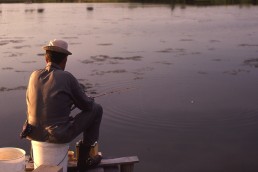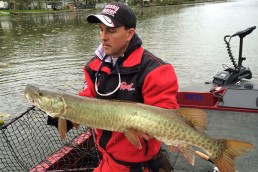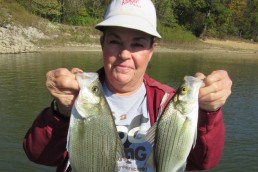Shelbyville Dam: Bank-fishing Muskies
SHARE THIS POST
For years I swore off the option of pursuing another fish species that might require its own array of gear and baits. When I spent time at my friend Greg’s shop, Fishing Connection, I would consciously avoid that section with those monster-looking baits—you know the ones larger than most fish found in the average angler’s fish basket. Baits, called “pounders,” not because of the sound they emitted but from their sheer weight, along with long-handled rods with the action of basically a “broomstick,” were all designed for the pursuit of one fish. One, that I was determined to avoid—the muskie.
Now it’s not like I have never caught muskies. My childhood summer vacations were often spent in northern Wisconsin near Eagle River. Muskies up there are not just another species, but to many, the only species.
I can remember those days sitting up on that little bench seat at the bow of a rather battle-scarred Lund. Besides fishing from that front seat, whoever chose to man that position accepted the responsibility of tending to the raising and lowering of the anchor, with no Power-Poles back then. From that position I would strain those copper-colored waters slinging Red and White Dardevles, Mepp’s Bucktails and muskie-sized Jitterbugs hoping for a bite, or if nothing else, just a follow-up.
Now, fast-forward from memory lane to today. Muskies are hardly the mainstay of typical gamefish pursued in the Chicagoland area. So as my fishing room tackle collection grew, muskie gear was nowhere to be found. Then it happened. One April day I was minding my own business, catching my share of early-spring crappies at Heidecke Lake. Armed with 6-foot, ultralight 4-pound-test and a 2-inch swimbait, I hooked what I assumed to be a large drum, which happens frequently at Heidecke. I didn’t see the fish immediately, so I figured I would entertain myself until the drum gave up or snapped my line. And after a long run, “it” rolled on the surface. This was no drum; it was a Heidecke muskie.
Now, the fishing got real serious. The I-don’t-care, just-snap-the-line attitude shifted to a heart-pumping question: How am I going to land this toothy adversary on 4-pound-test line with no leader and no net? As that muskie cruised by on what seemed to be about its twentieth pass, I could finally see my miniature swimbait hooked in the very tip of its toothy snout. Plotting out loud, if I could just keep that 4-pound line off those teeth, maybe I could hand-land this beauty. That muskie made me stumble up and down that rock bank as I tried my best to now keep that jig in place. I actually think that fish might have been a little entertained by my not-so-fancy footwork on the riprap and finally, either out of pure boredom or a bit sympathy for my rock-running, conceded and I hand-landed that green torpedo. I quickly taped it at 47 inches and gently revived it until the fish kindly gave me that face full of water from a tail flip and slowly descended into the depths. My hands and stomach were shaking after the release. Funny—you can land all kinds of decent fish, but a muskie just creates a totally different feeling deep inside, sort of on the level of going out on a first date. So the muskie addiction was on. Those tackle shop muskie “regulars” find great joy in watching you have to eat your words concerning their favorite fish as you line the counter with handfuls of once-ignored muskie baits and tackle. While muskie-fishing articles are quite common, bank-fishing muskies is not a typical story topic. But hey, I like the challenge and the payoffs have been surprising.
While I mentioned muskies at Heidecke Lake—which is a great Chicagoland choice for this article—we’re heading a little farther south toward central Illinois. Lake Shelbyville is our target destination for this month. For those who fish Shelbyville on the main lake, muskies are no surprise; they’re in good numbers and are caught frequently. But we’re heading to the other side of the dam, the spillway waters and to the banks of the Kaskaskia River. Standing near the dam spillway you hardly get a feeling that you are in muskie territory. Moving waters, concrete and rock just don’t emit that muskie-water vibe. But without a doubt they’re in there, from the wing walls of the dam itself, downstream to the Route 16 Bridge, and beyond.
Are you enjoying this post?
You can be among the first to get the latest info on where to go, what to use and how to use it!
Which brings up a good point: Where along this stretch of water will you encounter active muskies? The answer: Well, from the dam down to the bridge. Not trying to be wise or vague here, but really, depending on current flow out of the dam gates and bait availability, muskies can be up against the concrete of the bridge or farther downstream in the more natural, less turbulent river sections. If the dam is pushing out a lot of water, you need to locate slack water areas where muskies can retreat from the heavy current, but still be in close proximity to forage fish. Current breaks such as the dam wing walls, along the concrete stair area and near underwater rocks and concrete provide the sanctuary from battling the current, as does the transition area from the concrete structure of the dam and stairs to the more natural riverbank.
This past November I was finding active muskies farther downstream closer to the Route 16 Bridge, just out of the main river channel. They were hitting large rattling baits in a silver-with-black-spec pattern, resembling a crappie-type color scheme. I believe they were hunting down schools of river crappies, as some of the crappie anglers were catching fish in the same vicinity. I ended two days of fishing with seven muskies total—not huge fish, but in that 30-inch-plus range and very well fed. (Just a side note here, as I am guilty of it too: Seems like today, unless that muskie tapes out at 50 inches or better, it’s not worth talking about. That’s far from the truth and we need to enjoy these fish and be grateful just to land one and not obsess over size. These fish are awesome predators and not every fish can make the record books.) Done with my commentary, back to the point of predicting the location of these fish below the dam, I still believe it comes down to current flow and forage availability. Personally, figuring out the location of active fish is 50 percent of the excitement of this type of muskie fishing.
For you accomplished muskie anglers, I believe the main forage consists of crappies, bluegills and shad, so pack the appropriate colors and body styles. If you’ve never fished muskies, but would like to give it a try without investing into the gear needed, heavy bass gear will work. I would start with a heavy-action baitcasting rod and reel, 60- to 80-pound-test braid and a good quality muskie leader. Leaders not only serve as a means to prevent fish from biting off your bait, but they are also pro-conservation and mindful to the health of the muskies. You might not be too concerned about losing a bait due to a bite-off, but sometimes these baits can be lethal to a muskie if it is unable to shake off the hooks and bait, not allowing it to feed properly, and eventually, a slow death ensues. As far as compatible bass baits, natural crappies, bluegills and shad patterns work well. I like rattle baits, especially down in the more turbulent waters, making it easier for the fish to locate them. Large shallow-running crankbaits work well too. Spinnerbaits work, but muskies can turn your typical spinnerbait into a pretzel if they are not “muskie-grade” wires and hardware.
I’ve provided a marked sketch of where I have caught muskies and where I have seen them caught, as well as reports from friends. Just be confident this species is there below the dam; it just takes a little searching to pinpoint active fish, but once hooked, the search will be well worth the reward. After a muskie or two, I’m sure I’ll see you in the muskie aisle.
If you have any questions or comments you can reach Dan Brozowski at onthebank@att.net.
MWO
SHARE THIS POST
Did you enjoy this post?
You can be among the first to get the latest info on where to go, what to use and how to use it!
Dan Brozowski
Passion for angling drives Dan Brozowski to the water’s edge virtually any chance he gets. Although passion cannot be measured, weighed, or recorded, it can be shared. He does this through his writing and while on the water. If you have any questions or comments for Dan, you may contact him at: onthebank@att.net.



